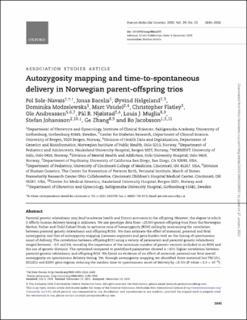| dc.contributor.author | Solé-Navais, Pol | |
| dc.contributor.author | Bacelis, Jonas | |
| dc.contributor.author | Helgeland, Øyvind | |
| dc.contributor.author | Modzelewska, Dominika | |
| dc.contributor.author | Vaudel, Marc | |
| dc.contributor.author | Flatley, Christopher | |
| dc.contributor.author | Andreassen, Ole | |
| dc.contributor.author | Njølstad, Pål Rasmus | |
| dc.contributor.author | Muglia, Louis J. | |
| dc.contributor.author | Johansson, Stefan | |
| dc.contributor.author | Zhang, Ge | |
| dc.contributor.author | Jacobsson, Bo | |
| dc.date.accessioned | 2022-01-31T08:17:05Z | |
| dc.date.available | 2022-01-31T08:17:05Z | |
| dc.date.created | 2022-01-19T10:01:48Z | |
| dc.date.issued | 2020 | |
| dc.identifier.issn | 0964-6906 | |
| dc.identifier.uri | https://hdl.handle.net/11250/2975801 | |
| dc.description.abstract | Parental genetic relatedness may lead to adverse health and fitness outcomes in the offspring. However, the degree to which it affects human delivery timing is unknown. We use genotype data from ≃25 000 parent-offspring trios from the Norwegian Mother, Father and Child Cohort Study to optimize runs of homozygosity (ROH) calling by maximizing the correlation between parental genetic relatedness and offspring ROHs. We then estimate the effect of maternal, paternal and fetal autozygosity and that of autozygosity mapping (common segments and gene burden test) on the timing of spontaneous onset of delivery. The correlation between offspring ROH using a variety of parameters and parental genetic relatedness ranged between −0.2 and 0.6, revealing the importance of the minimum number of genetic variants included in an ROH and the use of genetic distance. The optimized compared to predefined parameters showed a ≃45% higher correlation between parental genetic relatedness and offspring ROH. We found no evidence of an effect of maternal, paternal nor fetal overall autozygosity on spontaneous delivery timing. Yet, through autozygosity mapping, we identified three maternal loci TBC1D1, SIGLECs and EDN1 gene regions reducing the median time-to-spontaneous onset of delivery by ≃2–5% (P-value < 2.3 × 10−6). We also found suggestive evidence of a fetal locus at 3q22.2, near the RYK gene region (P-value = 2.0 × 10−6). Autozygosity mapping may provide new insights on the genetic determinants of delivery timing beyond traditional genome-wide association studies, but particular and rigorous attention should be given to ROH calling parameter selection. | en_US |
| dc.language.iso | eng | en_US |
| dc.publisher | Oxford University Press | en_US |
| dc.rights | Navngivelse-Ikkekommersiell 4.0 Internasjonal | * |
| dc.rights.uri | http://creativecommons.org/licenses/by-nc/4.0/deed.no | * |
| dc.title | Autozygosity mapping and time-to-spontaneous delivery in Norwegian parent-offspring trios | en_US |
| dc.type | Journal article | en_US |
| dc.type | Peer reviewed | en_US |
| dc.description.version | publishedVersion | en_US |
| dc.rights.holder | Copyright The Author(s) 2020 | en_US |
| cristin.ispublished | true | |
| cristin.fulltext | original | |
| cristin.qualitycode | 2 | |
| dc.identifier.doi | 10.1093/hmg/ddaa255 | |
| dc.identifier.cristin | 1984357 | |
| dc.source.journal | Human Molecular Genetics | en_US |
| dc.source.pagenumber | 3845-3858 | en_US |
| dc.identifier.citation | Human Molecular Genetics. 2020, 29 (23), 3845-3858. | en_US |
| dc.source.volume | 29 | en_US |
| dc.source.issue | 23 | en_US |

